Mr. Muthaf***in' eXquire, "Lou Ferigno's Mad"
by Incredible Hulk
Hulk not mad! Hulk GLAD!!! New rap song and video GOOD! Hulk appreciate cinema verite look at seedy New York City underbelly. (Hulk not watch at work.) Hulk like Mr. Muthafuckin’ eXquire flow and Hulk pump fist — BIG FIST!!! — to producer Constrobuz beat. Remind Hulk of Obie Trice’s “Wanna Know,” one of best songs EVER made by Shady Records! Hulk not mad. Hulk not even mind misspelling of “Ferrigno.” But Hulk confused. What song Constrobuz sample? Not Power of Zues’s “It Couldn’t Be Me” like Obie Trice. Rare-groove ’60s psychedelia not Hulk’s forte. Hulk know more about Independent Labor Party founder Keir Hardie.
Meanwhile, Bears Party Down In The Backyard
Wrestling, taking a dip in the pool… it’s all in a day’s PLAY for these Florida bears! (If I were this guy I would be a little cautious about banging the pots and pans together too.)
The No-Tears, No-Panic Thanksgiving Countdown Guide: The Final Week
The No-Tears, No-Panic Thanksgiving Countdown Guide: The Final Week
by Emerson Beyer
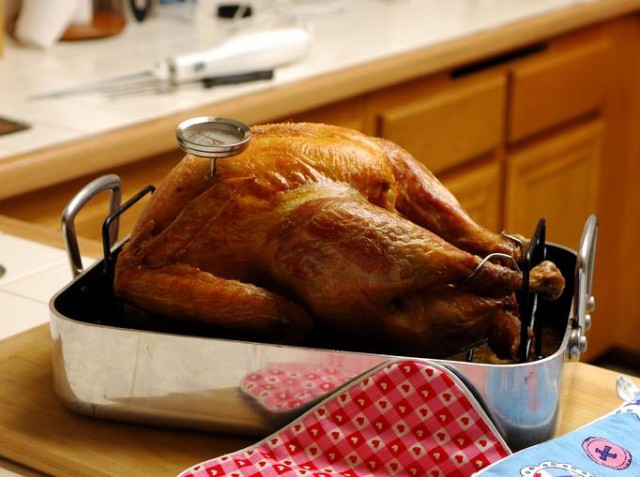
You guys, I couldn’t be prouder if I were a den mother ironing some gold arrow points on your scouting uniforms. You can head into the final seven days before Thanksgiving with your heads held high. When you get released from work early next Wednesday, you won’t be rushing to the grocery store. Instead, you’ll have time for an extended happy hour or to pick up your visitors from the airport, because your shopping is done, the sheets are pressed and dinner is waiting in the slow cooker. But even though you are in an advanced state of preparation, with little additional planning left to do, don’t yet retire to the bubble bath. You still have a turkey to roast! So read on for the truth about that, as well as some other tips for the home stretch.
Now, if you didn’t get through all your homework in the past two weeks, take solace. Even though Thanksgiving is the “Olympics of Entertaining,” there aren’t any medals for finishing first. Review Week 1 and Week 2, and catch up on the important stuff: sourcing a turkey, writing your menu and shopping list, making pie dough, checking your space and equipment constraints, and stocking the wine. If your welcome is true, the meal will be perfect in every meaningful regard.
Whether or not you need to make up overdue preparation, this weekend do go ahead and set the table. Trim the wicks on your candles. Make up the guest bed. Purchase and arrange the flowers. (By the way, remember when I said “no gourds?” I went to a dinner last week that had tables decorated with beautiful gray kabochas along with black stones and… so elegant — feel free to do that.)
Some “dos” for the days and hours leading up to the big meal:
• Measure out dry ingredients into zipper bags. Anything that requires measuring spoons or cups can be pre-portioned. This may seem excessive, but there’s nothing worse than needing a half-tablespoon to measure out sugar at a hectic moment, and the only one you can find is covered with olive oil. Mark the ingredients and associated recipe with a Sharpie on the outside of the bag.
• Print all the recipes you’ll need on Thanksgiving and tape them to the cabinet doors. Use Magic Tape, which won’t mess up the cabinets. No need to fumble with cookbooks or loose paper cluttering the counters. Keep that Sharpie handy for ticking off steps. When a dish is done, pull down the recipe and toss it in the dustbin.
• Wear an apron. Is this obvious? On Thanksgiving, it’s unlikely you’ll have time to take a last-minute shower before dinner time. Take your time getting ready in the morning — feeling put-together will boost your confidence and help you enjoy the day. Just wear an apron, because gravy stains are the nadir of schlubbiness.
• Use place cards. If anyone is a “newcomer” — especially if only one person is a newcomer — assigned seats will make everyone feel more welcome and comfortable.
And some “don’ts”:
• Don’t prep vegetables too early. Although you should get up early on Saturday morning to finalize your produce shopping at the farmers’ market, don’t cut things up too soon. Sweet potatoes, onions and garlic are some of the many things that don’t hold up. If you are cutting up a whole pumpkin for a side dish or for pie (which: fiiiiiiine, if you must), you can do that ahead of time, because it takes forever.
• Don’t make the pie too early. Ideally, you’ll serve the pie warm, and reheated pie, though delectable in its own way, doesn’t have the same thrilling freshness. If you time things right, you could even put the pie in the oven while you eat dinner, and it will be finished when the guests are ready for dessert.
• Don’t forget to use the microwave. Something about the traditionalism of Thanksgiving makes it seem like you ought to cook everything over a good ol’ flame. But the microwave will save you time and sanity. Use it for warming stock (for the stuffing) and making cranberry sauce.
A BIRD IN THE PAN
Obviously the highest-pressure component of the meal is the turkey. Everyone seems to agree that Thanksgiving turkey is 1. usually gross and 2. difficult to cook and 3. mostly a formality. I think this is one of those examples of conventional wisdom getting ahead of reality. Thanksgiving turkey is in fact almost always awesome! Even when it’s dry, it’s a great platform for parfaits of stuffing, gravy, and cranberries. So my advice on turkey is not “how to get it minimally edible” but rather “how to make it succulent.” Here’s a size- and temperature-agnostic roasting guide that covers all the options.
You already know about brining, and that’s something you’ll have to start on Wednesday. But there’s more:
• Get the bird to room temperature before it goes in the oven. Take it out of the brine/fridge first thing Thursday morning and let it sit out — covered, obviously — away from heat, sunlight, and pets. (You can put the white wine in the fridge as you take the turkey out.) If this skeeves you out at all, just think of this warming as a slow part of the overall cooking process.
• When you prep your onions, celery and carrots, make enough for stuffing and gravy at the same time. If you’re going to make your gravy directly in the roasting pan (see below), spread about 1–1/2 cups of these diced vegetables in the pan under the rack and turkey. (If there is no rack, you can rest the turkey on thick slices of onion, but don’t put diced vegetables in the pan.)
• Don’t stuff the bird. Instead, put “aromatics” in the cavity. The traditional aromatics would be a lemon cut in half, some sprigs of rosemary and thyme, and maybe an apple with cloves spiked into it. Make the stuffing in a separate baking dish or in the slow cooker, which will save you crucial oven space. (Don’t forget to use your homemade turkey stock for the stuffing!)
• Cut off the tips of the wings. If they don’t have a lot of pin feathers, reserve them for later use. Loosely loop some twine around the “ankles”; if you don’t do this, the legs will spread indecently as the bird cooks.
• Put a ping pong ball-sized piece of the compound butter you made last week under the skin on each side of the breast. This is a surefire way to get delicious white meat that doesn’t turn to shoe leather as it cools.
• Put even more butter all over the skin. Seriously, then probably invest in a dairy farm. Children should be making paper cutouts of cows this month, not turkeys. Butter! BUTTER!!
• If you took my advice and have a bird of reasonable size, use high-temperature roasting. That’s 500F for 2 to 2–1/2 hours. No flipping, no basting. There are some additional details you need for high-heat roasting that you can get from the leading evangelist of this technique, Barbara Kafka.
• If you got a giant bird (20 pounds or more), the high-temperature thing is not going to work. You need a way to deal with the unequal speed with which the dark- and white-meat parts will cook so that you don’t have raw drumsticks or desiccated breasts. The solution is to start the bird roasting breast-side-down for an hour at 400F. After that, flip it over, lower the heat to 325, and keep roasting until the thigh registers 165F.
• You do have a meat thermometer, right?
• Rest the turkey, tented with foil. Don’t serve the turkey straight out of the oven. Resting (according to Harold McGee, and borne out by experience) is another crucial way to make the meat juicy. I think it has something to do with cell membranes.
Even if everything goes terribly wrong with the roasting, there is no turkey so bad that gravy can’t fix it. Your gravy is going to be awesome because you have already crafted two crucial tools: homemade turkey stock and beurre manié! Here’s how to use them:
1. When the turkey comes out of the oven, transfer it to a serving platter or carving board. If you used a big, heavy-duty pan, you can put it right on the stovetop over two burners. If your pan is lightweight or oval (please don’t use an unsafe disposable foil roasting pan), get a friend to help you scrape all of the drippings into a big skillet or sauté pan.
2. Turn the burner(s) to medium-high. If you didn’t cook your celery, carrots, and onion under/with the turkey, add them now. Add the wing tips if you reserved them and the giblets except for the liver. Depending on the amount of turkey fat in the pan, add one or two tablespoons of beurre manié. Get everything really dark brown.
3. Add a cup of wine to the pan and immediately start to scrape, scrape, scrape. The wine will cook off quickly, so work quickly. What wine? Whichever is the cheapest bottle you have open at the moment. White, red, pink — it doesn’t matter, just nothing sweet. You could even use beer or whiskey.
4. Lower the heat to medium. Add turkey stock. You want to reduce by about half, so use approximately twice the volume you need. As it cooks down, it will thicken beautifully. But if you need additional weight, add more of your beurre manié a tablespoon at a time.
5. This will take a while! Maybe half an hour. It’s okay, your turkey needs time to rest. Be patient. When the gravy looks like gravy, run it through a mesh strainer. I am of the opinion that you don’t need to try to separate the fat out at this point. Later, if you have leftover gravy, the fat will rise and solidify in the refrigerator — you’ll want to scrape that off, it’s gross.
THE AFTERMATH
Okay, now enjoy eating! Try to have a civil conversation! We always start with a toast to our loved ones who can’t be with us because of distance or death, and take a moment remember the troops — this definitely helps rein in any pettiness.
After all this work, you’re likely to be pretty keyed up and the weekend may seem less relaxing than straight-up boring. Someone is going to tune the television to USA Network for a “Psych” marathon or something. So, consider having projects ready, such as testing Christmas lights, dipping candles, or writing out cards. If you moved in the past year, getting your holiday cards out the door early is a very good way to make sure everyone has your address for their cards, so they don’t have to ask you for it over Facebook!
Emerson Beyer is thankful for having a great view from his writing desk and a husband who makes perfect risotto. (Happy birthday, Professor!) He lives in Durham, NC and tweets as @patebrisee.
Photo by Brent Reeves, via Shutterstock.
25 26 Arrested Reporters and What They Do
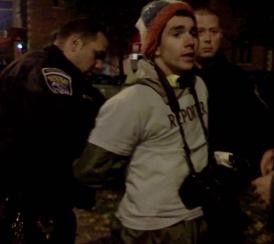
Put together by Josh Stearns, this document has been a great resource to track journalists working on Occupy Wall Street stories around the country who’ve been arrested. So who are they? Only seven of the 25 arrested are full-time employed traditional news-gathering employees. A number were student reporters; a few were interns; a larger number were freelancers. Some work for traditional “objective” news organizations; others work for “non-objective” news organizations, like Alternet and Indypendent Reader. This means something — mostly about the media and what it is now, possibly also who the police perceive as media and relation of reporter to demonstration. But with the exception of a Journal-Sentinel photographer, two AP folks and one Daily News reporter, no major traditional news outlets have (yet!) had staff reporters or photographers arrested. As Erika Fry pointed out last month in CJR, this also has to do with who police departments consider a journalist, and why they decide that. (Turns out, wearing a shirt that says “reporter” doesn’t always help in the eyes of the police, as one Rochester student discovered.) A minimum of 40% of people news-gathering who were arrested are women.
• Natasha Lennard: Non-contract freelancer, now not covering politics for the Times.
• Kristen Gwynne: freelance writer and editorial assistant, Alternet.
• Marisa Holmes: Documentary filmmaker and activist, OWS organizer.
• John Farley: multimedia web editor, WNET/Thirteen’s MetroFocus.
• Bob Plain: recently laid off, at the time of the arrest was a digital reporter for WPRO.
• Jonathan Meador, reporter, Nashville Scene.
• Susie Cagle, freelance artist and cartoonist.
• Ian Graham, freelance photographer, RVA Magazine.
• Kristyna Wentz-Graff, staff photographer, Milwaukee Journal Sentinal.
• Stephanie Pharr, intern, Creative Loafing.
• Alisen Redmond, Kenneshaw State University Sentinel.
• Judith Kim, Georgia State University Signal.
• Jonathan Foster, photographer, Rochester Institute of Technology’s student Reporter Magazine.
• Julie Walker, freelancer, NPR.
• Jared Malsin, freelancer, East Village Local The Local East Village (a “collaboration” of often unpaid labor between NYU and the New York Times).
• Unknown, photographer, Agence France-Presse.
• Justin Bishop, photographer on assignment for Vanity Fair.
• Matthew Lysiak, reporter, New York Daily News.
• Karen Matthews, AP reporter.
• Seth Wenig, AP photographer.
• Patrick Hedlund, news editor, DNAinfo.
• Paul Lomax, freelance photographer.
• Doug Higginbotham, a freelance video journalist, TV New Zealand.
• Ryan Harvey, musician, correspondent for Indyreader.
• J.A. Myerson, freelancer, TruthOut.
• Keith Gessen, editor, n+1. (Along with “kathleen ross, and sarah leonard of n+1, dissent, and the #ows gazette” as per Charles Petersen. They were not engaged in reporting per se, but in demonstrating. But where do reporting and demonstrating diverge? There will be an essay to tell us about that later, I suspect.)

Keith Gessen arrest photo from this morning by Daniel Massey.
Photo of Rochester Reporter reporter being arrested by Dan DeFelippi.
Nice Lillards Finish Last

Matthew Lillard: I made great money in Scooby Doo 2, but that was ten years ago. I just thought, ‘I’ll make a lot of money.’
BlackBook: Did you think that at one point?
Matthew Lillard: Sure. I was like, ‘Oh dude, I’ll always work.’ And also, I’m fun to work with and I’m not a guy that’s hard to get a long with. I’ve never had a bad experience with anyone, I’ve never been late, I don’t do drugs. You know, I wish I did. I wish I would beat a woman, do drugs, get arrested, kill a dog.
BlackBook: Then you would have starred in Iron Man!
Matthew Lillard: Yes dude! And then do something really amazing and people are like, ‘Oh, it’s a comeback.’
Overhead Views of Rough Arrests on Broad Street
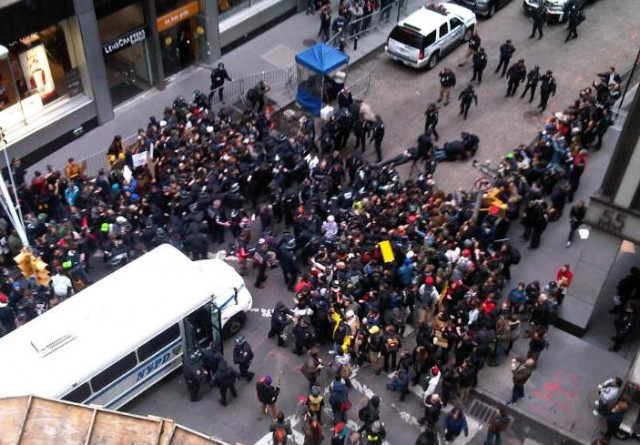
Views from above, on Broad Street, at Beaver Street.
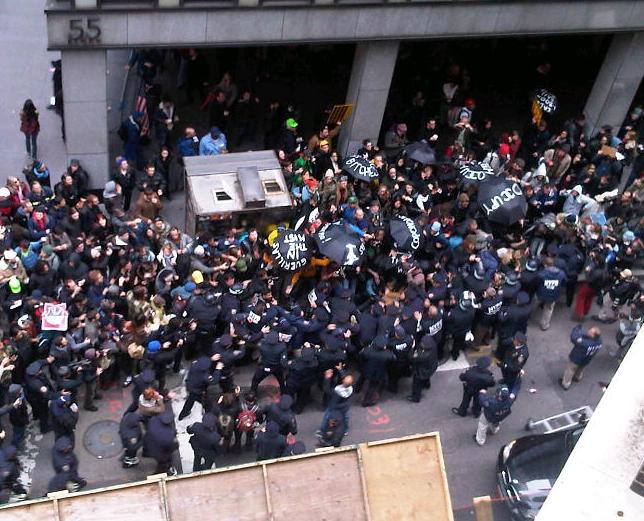
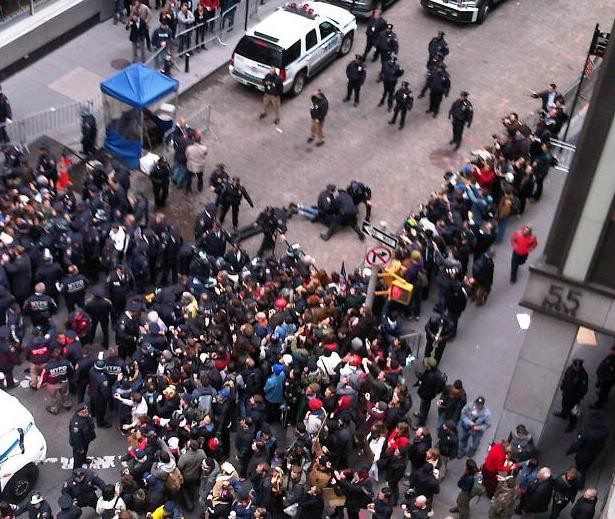
Photos by Matthew R Smith, OWS Sympathizer and Wine Publicist who just happens to work in the Financial District, much to his daily dismay.
The Bank of America Occupation is Already a Great Moment in History
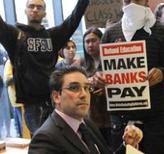
In case you east coasters missed last night’s occupation of Bank of America in San Francisco, it’s truly wonderful. And this picture is something I hope our great-grandchildren see. (If The Machines that run the banks that will be running the government by then let them see any pictures, of course.) Sounds like Bank of America doesn’t really even need our help in running the business into the ground though — and trying to take America with it as it prepares to cut 30,000 jobs. Meanwhile, right now in New York….
Sounds like lots of folks are being carted off to jail. And this is also happening.
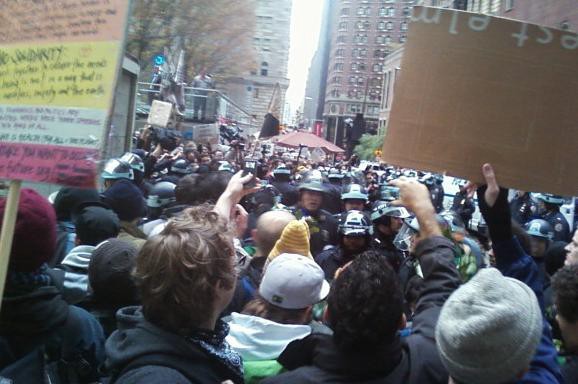
(Photo by Caroline.)
Also this is a wonderful picture outside Starbucks by Wall Street.

(Photo by Lucy Kafanov.)
Bloomberg's Dumb Tactics Result in Occupation of Wall Street
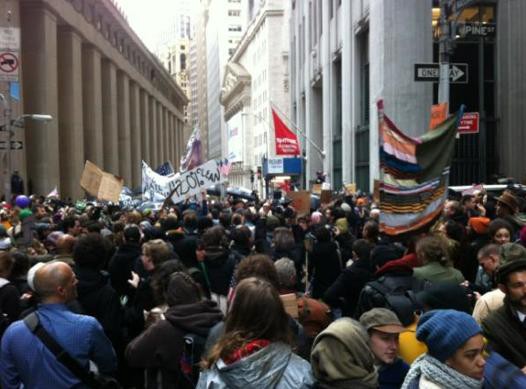
So Mike Bloomberg’s eviction of Occupy Wall Street has actually resulted in a large protest this morning that is actually occupying Wall Street. You just know there’s a team of mayoral advisors, familiar with the First Amendment, who are sitting in an office right now with their arms crossed, being all “la la la, told you so.” More good pics here. Arrests are already taking place.
Photo by CBC superfox David Common.
What If Scotland Divorced the UK?
by Jennifer O’Mahony
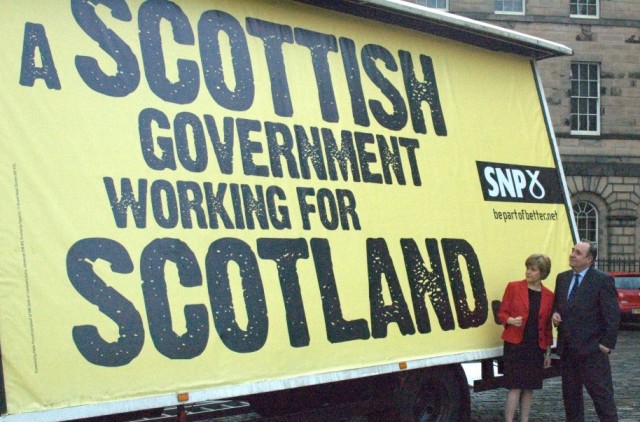
“If the Scottish parliament votes to have an independence referendum, that’s a vote that we would have to respect and we would have to allow that and enable that to happen.” — British Prime Minister David Cameron, June, 2011.
Scotland may leave the United Kingdom. This stark truth has escaped the notice not just of the international community, but of most British people too. They don’t really yet believe that our country could once again be split just north of the wonderfully named border town of Berwick-upon-Tweed.
Life north of that border has always been different, with a separate legal system, currency, and, of course, wedding outfits, but the momentum building behind the Scottish National Party (SNP) and its leader Alex Salmond is historic, not symbolic, in its agenda.
300 years have passed since the Act of Union that brought England and Scotland under one crown, one parliament and a single language, but until the SNP won an unexpected victory in 2007, few believed that Mel Gibson’s dream in Braveheart would ever happen for real.
In 1999, the British Labour party passed a law giving Scotland a devolved assembly (like Wales and Northern Ireland), now known as the Scottish Parliament. The Parliament itself was a step into the unknown, and the chances of a small, left-wing party with separatist tendencies must have seemed slim. What the SNP had, however, was the sheer rage of three centuries of waiting driving them on.
When Winnie Ewing opened the Scottish Parliament for first time on May 12, 1999, she invoked the spirit of those centuries. “The Scottish Parliament, adjourned on the March 25 1707, is hereby re-convened,“ she declared.
Eight years sitting patiently in the wings, and four years in power later, the SNP has abolished all tuition fees for Scottish students, all healthcare costs (English people pay a low set fee per prescription), and it plans to create 130,000 green jobs within a decade.
So far, so socialist utopia — but the issue of independence is only now coming to the forefront of the SNP’s strategy as it seeks to consolidate the support of Scots who used to vote primarily for the national Labour or Liberal Democrat parties.
The main problem English people have with Scotland is not a nationalistic one, but a financial one. Each of Scotland’s 5.2 million people receives from the British government in Westminster services in the amount of £1,624 more per year than your average English person. The aforementioned socialist utopia does not come exclusively from Scotland’s own economy, and to add insult to injury, that free tuition commitment doesn’t apply to English students studying at Scottish universities.
For many of the 51 million people in the UK who are English, Scottish nationalism is therefore an attractive proposition to save precious government funding for themselves.
Pro-independence Scots believe exactly the same thing. Their logic is rather that the English are constantly stealing from them in the form of revenue from the shared North Sea oil fields, and that the subsidy argument disguises the true strength of Scottish finances. Note: this is the part of the SNP’s ambitions that could lead to a potential civil war.
Nevertheless, the SNP believe that with oil revenue and their own brand of social democratic separatism, Scotland would be infinitely more successful as a nation state than as England’s less populous, cruelly overlooked neighbor.
The question is: how this will happen.
In the next five years, the 12-year-old Scottish Parliament will almost certainly win more powers away from the British government, but, depending on Scots’ ability to accept a nation with an uncertain economic future, we could also potentially see Scotland replace South Sudan as the world’s newest country.
For the immediate future, that will rest on the question of a referendum, the terms of which are currently being fought out by Edinburgh and London. Only the British Parliament and the UK Supreme Court have the constitutional right to allow or block Scotland leaving the union of England, Northern Ireland, Scotland, and Wales. For it to happen, Parliament would need to pass a law or hold a referendum, potentially allowing everyone in the UK to make that decision (which would almost certainly result in the perpetuation of the status quo).
The Scottish government wants a referendum that would allow Scottish people exclusively to decide if they want to be independent. An added complication is that Alex Salmond, Scotland’s fourth First Prime Minister, wants two questions on his version of the sheet of paper: “Yes or No” to complete independence and “More power or complete independence” as a second consideration.
The consolidation of power just short of secession in the second question is termed “devo max” by Mr. Salmond, and is seen as a way of biding time and appropriating more power on policies like tax before trying again on full independence at a later date.
If the SNP lost their referendum outright, it would set back their ambitions considerably, but this is very unlikely. In the most recent poll, 33% of Scots favored giving Scotland more control over tax and benefits while remaining part of the UK, and 28% supported complete independence.
There is a clear majority demanding more power for Scotland, but they are split over quite how much. If the SNP could maximize its power center in Edinburgh, taking more and more responsibility away from the UK government, it just might get the mandate required to call another, later referendum on independence, and this time it could win.
It would need the support of the British government, and would have to avoid a block by the Supreme Court, but the principle of self-determination for Scotland in some form is broadly accepted by all three major British parties.
For Salmond, an independent Scotland is a fantasy sketched out in some detail. He has said that Scotland would unilaterally join the EU, that the Euro would be its currency, and that it would have an army, navy and air force that “would cooperate with our western allies in a range of engagements.”
Salmond likes to recall all the Scotsmen before him who have fought for independence, placing himself in a long line of those wrestling power from the tyrannical English. “In my heart, in my head, I think Scotland will become an independent country within the European community, with a friendly, co-operative relationship with our partners in these islands,” he once said. Don’t underestimate the force of 300 years of dreaming.
Jennifer O’Mahony is a British journalist currently based in Edinburgh, Scotland. She posts as @jaomahony on Twitter.
